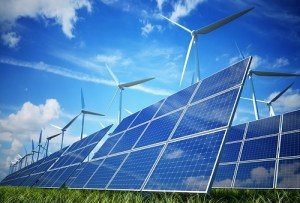Major transmission company Transgrid says 100 per cent renewable energy is both feasible and affordable, and is urging policy makers to “step out in large ways” because incremental change will not deliver climate goals or potential cost savings.
“We are talking about rebuilding the generation system in this transition,” Tony Meehan, the company’s head of regulation, told the Australian Clean Energy Summit in Sydney this week.
“A 100% transition to renewable energy can be feasible and can be met in a way that is affordable for consumers,” he said. He noted that the energy mix would be met not just by large-scale renewables, but by “behind the meter” PV, storage, demand management and energy efficiency.
Meehan said the current investment in large-scale wind and solar was exciting, but the country would “need to step out” and add renewables in the thousands of megawatts to ensure that energy costs came down.
 Meehan produced this graph above to illustrate where some of the wind and solar resources could be exploited, many in areas currently unserved by transmission lines.
Meehan produced this graph above to illustrate where some of the wind and solar resources could be exploited, many in areas currently unserved by transmission lines.
(Apologies for the quality of the slide: The orange shaded areas each show potential of 5,000MW of large-scale solar capacity, while the green shaded areas each show 3,000MW of wind energy potential. In the blue, Snowy has potential for 8,000MW new capacity).
“Our focus is probably not to look at places where people already looking,” he says. “We have identified zones in NSW where we could add tens of thousands of megawatts of large -cale solar, and north-west Victoria and western NSW have got lots of wind.
“People are not looking there because the areas are not serviced by transmission.”
Transgrid, of course, has an interest in building new transmission lines, because operating them is its core business. But Meehan said that transmission would only comprise around 4 per cent of the total cost of a renewable energy transition, which he said would bring down prices.
But apart from using transmission as a platform towards more renewables, he said new mechanisms that could provide ancillary services and a market design appropriate to the future energy mix was also needed, one that prompted genuine competition and protected consumers.
There has been an increasing focus on transmission, lately, because of the need to build enough renewable energy plants to make up for the loss of capacity from coal-fired power stations that are slated to close. Liddell in NSW is the next to shut its doors, with its 2GW of capacity due to come off line in 2022.
ITK analyst David Leitch made the same call earlier this month, underlining the importance of new transmission lines. Others are pushing for new connectors to Tasmania, to unlock that state’s huge wind reserves and its potential to be a “big battery”, as well as new links to South Australia.
It is not the first time that Transgrid has spoken of very high penetration renewable energy scenarios, having outlined a vision for 95 per cent renewables just a few months ago.
Meehan’s comments also underline the fact that 100 per cent renewable energy scenarios are no longer solely the province of environmental NGOs and university researchers, and contradict claims by the federal government and conservatives that even 50 per cent renewable targets are “reckless”.
The CSIRO and Energy Networks Australia – of which Transgrid is a key member – last year combined to produce a roadmap for a zero emissions grid way before 2050, an undertaking they said would save $100 billion off the cost of business as usual and deliver significant savings to consumers.
By contrast, the Finkel Review, which only entertained a modest transformation of 42 per cent renewables by 2030, and zero emissions by 2070, spoke of only modest reductions in bills.
But with the falling cost of wind and solar, and predictions such as those of Bloomberg New Energy Finance that the cost of solar will beat even existing coal plants by 2032, there is growing realisation that renewable energy, combined with smart demand management and energy efficiency, is the key to cutting costs.
Meehan also said there was much greater potential in the Snowy Hydro scheme – putting it at 8,000MW of new capacity, rather than the 2,000MW identified in the federal government’s Snowy 2.0 pumped hydro proposal.
“We are seeing very much the start of the transition,” Meehan said. “We have got 1,000MW in wind and solar under construction as we speak. The transition is underway ….. but we need to facilitate a lot more, we need an intensive effort around planning. Time is short.”











